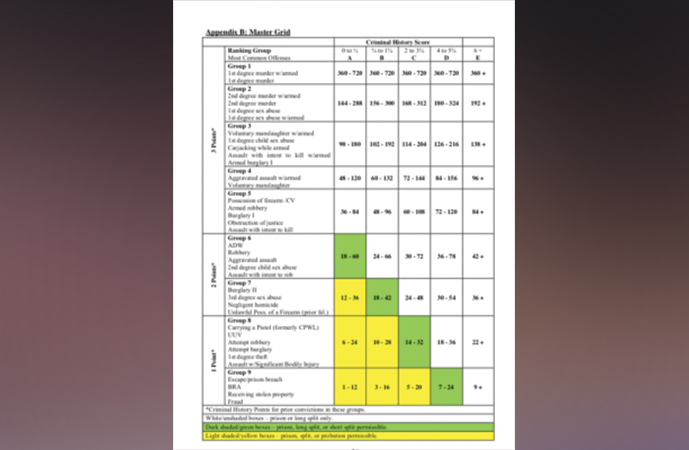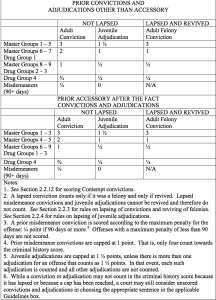
Thank you for reading D.C. Witness. Help us continue our mission into 2024.
Donate NowBy
D.C. Witness Staff
- January 9, 2019
Court
|
Homicides
|
Policy
|
Suspects
|
The criminal history score takes multiple facets of information into consideration, starting with whether or not the defendant has a prior conviction.
The score is determined by the severity of the offense and whether or not it is drug-related.
When determining a defendant’s sentence, judges utilize voluntary sentencing guidelines created by the District of Columbia Sentencing Commission. The sentencing guidelines are formed in a chart aligning a defendant’s criminal history score and their charge, which points to a sentencing range that judges can follow.
The guidelines were a product of the Revitalization Act of 1997, which allowed the transfer of prison expenses from the state to the federal government. Considering DC felons are sent to federal prisons, a more determinate system was required for sentencing. The transition led to the creation of the sentencing guidelines. The guidelines came into effect in 2004 as a pilot project.
For example, according to the Washington Post, former NBA basketball player, Gilbert Arenas, was sentenced in 2010 for carrying a pistol without a license. Arenas had a criminal history score of 1/4 point, so his sentencing range fell between 6-24 months. If Arenas had a criminal history score greater than 1/2 point, he could have faced between 10-36 months in prison.
If a defendant has a prior misdemeanor “conviction or adjudication” within the last 10 years then it counts toward their criminal history score. However, if the end of the prior misdemeanor sentence (including the period of incarceration, probation, parole or supervised release) is not within the last ten years then it doesn’t affect their criminal history score.
On the other hand, if the prior conviction is a felony then it will always affect the defendant’s criminal history score, even if it was before the 10-year mark.
According to the commission, the guidelines have a 97 percent compliance rate. However, even with such a high rate, there are certain circumstances in which judges can depart from the guidelines. One instance of noncompliance is the 11(c)(1)(c) rule. This rule allows judges to be bound to a plea agreement offered by both parties even if the agreement falls below the sentencing range.

Figure 1: The following chart depicts the sentencing guidelines.
In July the commission changed unlawful possession of a firearm with a prior conviction from Master Group 7 to Master Group 8 (see Figure 1). The change, which only affects cases from July on, permitted a lower criminal history score in relation to the charge and thus a lower sentencing range for the defendant (10-28 months, see Figure 2). According to the commission, the change was made so defendants wouldn’t be penalized twice for the same crime.
Along with the commission, judges also take the guidelines into consideration. The guidelines, which are mandated, can according to each case be rejected. One example of a rejection of the guidelines s with the sentencing of co-defendants Tyrone Height and James Young. Height and Young were convicted of second-degree murder for shooting 38-year-old Willard Carlos Shelton in 2014. One of their charges was unlawful possession of a firearm with a prior conviction.

Figure 2. Prior adjudications and convictions chart adapted from Voluntary Sentencing Guidelines Manual
During Height’s sentencing in September, his defense attorney, Justin Okezie, said that Height should not be penalized further for being part of a community with a history of violence. He urged the judge to adjust Height’s criminal history score based on the guideline change. Okezie said an incident Height was involved in one month earlier should not “magically” have meaning to it.
While Judge Milton Lee agreed the added enhancement “with a prior conviction” could be viewed as “double-counting” the defendant’s previous convictions, he ultimately decided not to implement the guideline change to determine Height’s sentence. Prior to sentencing the defendant, Judge Lee noted that Height has a significant criminal history. Height was sentenced to 45 years in prison.
Like Height’s case, murder defendants can be sentenced to decade or more in prison because of the impact of their criminal history, even if they have lesser charges. For example, a defendant with a criminal history of six or more is placed under category E in the sentencing guideline (Figure 1). If this defendant was charged with second-degree murder, for instance, he/she could still receive 192 months or more in prison because of the added weight their prior convictions carry (Figure 1).
In addition to the guideline shift regarding unlawful possession of a firearm with a prior conviction, the commission continues to explore the relationship between the criminal history score and other factors involved in sentencing.
Follow this case